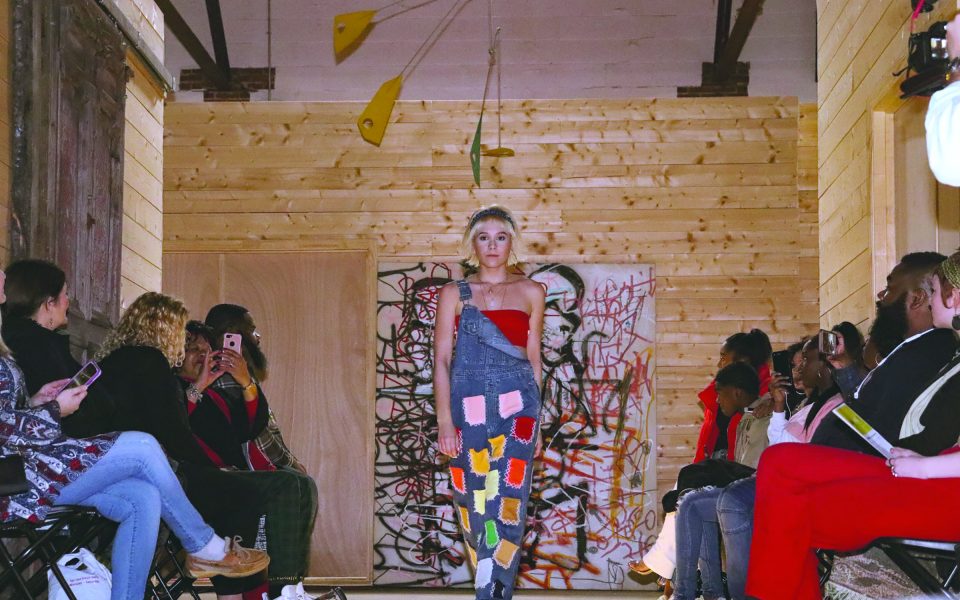All my clothes have backstories.” Anwar Alston said before a runway show at Studio 503 in Greensboro.
The 22-year-old designer behind [strive/arrive] put his recent line on display in a Winter Collaboration Showcase with Lizzie Barnhardt of the Striped Lemon this on Dec. 29. Both of the designers specialize in refurbishment to play up the transformative elements of casual and high fashion streetwear. They combined their personal aesthetics and names for the evening as [strive/LEMON].
The walls of Studio 503 matched the fashion line, as a patchwork of paneling and brick peeked out from behind tan paint. The industrial room sported exposed piping and wooden slats, and the floor filled with rows of chairs, with two strings of lights parting a pathway down the center. The lights dimmed, and an exhibit of streetwear commenced.
The showcase served as Alston’s third show just as his label [strive/arrive] hit its first anniversary. However, he first discovered a zeal for fashion at age 16. Wanting to keep up with trends, he made his own short-sleeved hoodies instead of buying them. The pastime morphed into T-shirts and then into a fully-fledged brand.
Alston drew from past events to weave specific feelings and ideas into his designs, with each piece holding a bit of personal history for the 22-year-old. He used the word “uniform,” to tie together a selection of slightly different works, exploring the ideas behind the Standard Mode of Dress, or SMOD, fashion that influenced his years in school.
Alston’s approach subverted expectations. Colors covered blocks of a half-tucked shirt. Frayed edges and bright stitches of thread broke up blue denim. Alston took a flannel and flipped it around, so when the model tied it around his waist, it gave off the same vibe as a skirt.
“I love being confused,” Alston said. “It just makes stuff so much better.”
The show was 19-year-old Lizzie Barnhardt’s debut in the Triad design scene. Barnhardt’s interest in refurbishment stemmed from an enjoyment of Goodwill and thrift shopping. The hobby drove Barnhardt’s curiosity for altering articles of clothing for three years until she founded her brand, the Striped Lemon, in the summer.
The designer confronted the nature of the articles she found head-on, often finding herself dumping out large plastic bags of old or unwanted items. She rifled through her picks, examining the details of each shirt, pair of pants or mechanic jumpsuit to sculpt them into modern trends.
“We’re putting our own twist on it,” she said.
Barnhardt employed a combination of casual streetwear with bold prints and patches, with inspiration from vintage looks like baggy pants. A pair of open-back overalls maintained a relaxed appearance with red and yellow popping against dark hues in a plaid pattern. A series of black lines formed faces down both legs of white, high-waisted pants.
Items from both lines created seamless outfits, as the designers built off of one another’s tastes. A gun holster designed by Alston matched a striped shirt from Barnhardt. The neutral tones on a pair of pants from the Striped Lemon balanced with yellow on a collared shirt from [strive/arrive].
While Barnhardt and Alston took varied steps towards the creative process, they both noted that fashion acts as an everyday antidepressant. Alston set out to channel specific emotions into his work by recalling a singular feeling to compile collections. Barnhardt credited her sewing machine or just looking through fabric as an instant mood-lifter.
“I have a huge scrap bin and I’ll just go through it,” Barnhardt grinned.
Barnhardt admitted organizing a fashion show proved more complex than anticipated, like juggling being a designer with being an event-planner. However, the maker seemed determined for more.
“I definitely want to keep having more shows,” Barnhardt said, “and build my brand from here.”
Join the First Amendment Society, a membership that goes directly to funding TCB‘s newsroom.
We believe that reporting can save the world.
The TCB First Amendment Society recognizes the vital role of a free, unfettered press with a bundling of local experiences designed to build community, and unique engagements with our newsroom that will help you understand, and shape, local journalism’s critical role in uplifting the people in our cities.
All revenue goes directly into the newsroom as reporters’ salaries and freelance commissions.


Leave a Reply